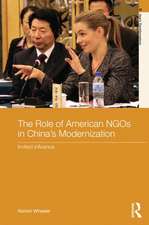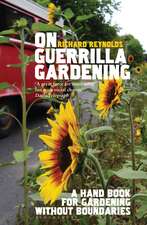Diplomacy and Negotiation for Humanitarian NGOs: Humanitarian Solutions in the 21st Century
Autor Larry Winter Roeder, Jr., Albert Simarden Limba Engleză Hardback – 25 mai 2013
| Toate formatele și edițiile | Preț | Express |
|---|---|---|
| Paperback (1) | 698.00 lei 38-45 zile | |
| Springer – 23 iun 2015 | 698.00 lei 38-45 zile | |
| Hardback (1) | 580.10 lei 38-45 zile | |
| Springer – 25 mai 2013 | 580.10 lei 38-45 zile |
Preț: 580.10 lei
Preț vechi: 716.17 lei
-19% Nou
111.05€ • 115.44$ • 92.08£
Carte tipărită la comandă
Livrare economică 03-10 februarie 25
Specificații
ISBN-10: 1461471125
Pagini: 476
Ilustrații: XVIII, 456 p.
Dimensiuni: 155 x 235 x 29 mm
Greutate: 0.84 kg
Ediția:2013
Editura: Springer
Colecția Springer
Seria Humanitarian Solutions in the 21st Century
Locul publicării:New York, NY, United States
Public țintă
Professional/practitionerCuprins
Chapter One: Why Learn “NGO Diplomacy?”.-Extract:.- 1.1 What is NGO Diplomacy?.- 1.2 NGOs as a Force for the Sovereignty of People.- 1.3 NGOs in the Multilateral World.-1.4 NGO Independence.- 1.5 What is Humanitarian?.-1.6 A Model for NGO Diplomacy.- 1.7 Historical Precedent:.- 1.8 Dr. Fridtjof Nansen.- Chapter Two: A Practical Model For Diplomacy and Negotiation: Steps 1 – 3 - The Preliminary Stage Extract:.- 2.1 Introduction to the Model -- Three Phases:.- 2.2 Steps to Success and Managing Costs.- 2.2.1 Step One: Is The Initiative Worthwhile and Feasible?.- 2.2.2 Step Two: The Study Group Process.- 2.2.3 Two sets of questions need to be asked in steps one and two.- 2.2.4 Question Set Two: How Will the Goal Be Achieved?.- 2.3 The Study Team.-2.3.1 The Study Team Must Ask Hard Questions.- 2.3.2 Keeping Your Cool.- 2.4 Step Three: The Decision Memo -- Go or No Go?.- 2.4.1 The Off-Ramp.- 2.5 Delegation and Negotiation Staff Decisions:.- 2.5.1 The Delegation.-2.5.2 The HQ Team.- 2.6 Why the Lengthy Decision Process?.-Chapter Three: A Practical Model For Diplomacy and Negotiation: Steps 4-6 – The Negotiation and Implementation Stages.- Extract:.- 3.1 Introduction -- Three Phases:.- 3.2 Step Four: Position Papers – Delegation Guidance.-3.3 Step Five: Binders and Reports.- 3.3.1 The Delegation Binder.- 3.4 Chief of Delegation and Team Leader.-3.4.1 That which deflects from true success is failure.- 3.5 Coordinated Instructions.- 3.6 Tactics.- 3.6.1 Have a Draft In Hand.- 3.6.2 “What Is Our Mandate?” Delegations.-3.6.3 Moral Suasion.-3.6.4 Coercion.- 3.6.5 Chatham House Rules.-3.6.5 The North South Problem.-3.7 Interdisciplinary Complexity.-3.8 Standard Rules of Behavior.- 3.8.1 Do the Rules Always Apply? Challenge Axioms.- 3.9 Using An Opponent’s Strategic Objectives:.- 3.10 Time Management.- 3.11 Other Points:.- 3.12 Contacts and Cooperation.- 3.12.1 Cooperation With NGOs.- 3.12.2 Cooperation with Corporations.- 3.12.3 Personal Contacts.- 3.12.4 Contact and Steering Groups.- 3.13 Field Negotiations.- 3.13.1 Know the Other Side.- 3.13.2 Perspective.- 3.14 After Action and Implementation.- 3.14.1 After-Action Report.- 3.14.2 After Action Review Session.- 3.14.3 Implementing an Agreement.- Chapter Four: Information and Knowledge Management.- Extract:.- 4.1 Introduction.- 4.2 Management Framework.- 4.3 Knowledge Management.-4.4 Knowledge Work.- 4.5 Integration.- 4.6 Conclusions.- Chapter Five: Security, Risk Analysis and Intelligence.- Extract.- Introduction to Chapter Five.- 5.1 The Need For Profiles – and Using a Data Fusion Tool to Help.- 5.2 Case Studies.- 5.2.1 The Relationship of Drought and Political/Economic Crises in Africa.- 5.2.2 The 2009 Swine Slaughter in Egypt.- 5.2.3 Civil War.- 5.2.4 The Sinai Peninsula in 2012.- 5.2.5 Poland in 1982.-5.3 Possible Annual Reports.- 5.3.1 Annual International Organization Report.- 5.3.2 Annual Voting/Consensus Practice Guide.- 5.4 Doveryay, no proveryay Дoвepяй, нo пpoвepяй: Trust But Verify.- Chapter Six: Legal Matters.- Extract:.- 6.1 Delegation Legal Adviser.- 6.2 Sanctions and Legality.-6.2.1 United Nations Sanctions.- 6.2.2 National Sanctions and Restrictions:.- 6.2.3 Sanctions on Non-State Entities.- 6.2.4 International Courts:.- 6.3 Words Matter.-Case Study: Cultural Sensitivity in the Middle East.-6.4 Generic Problem Words and Phrases.-6.4 Value of Written Constitution.- 6.5 International Humanitarian and Human Rights Law.- 6.5.1 International Human Rights Law (IHRL) always exists,.- 6.5.2 International Humanitarian Law (IHL) only exists in conflict.- 6.6 International Instruments.- 6.6.1 Will the Instrument Solve the Problem?.- 6.6.2 Leverage.- 6.6.3 The Authority to Negotiate.- 6.6.4 Memoranda of Understanding (MOU).-6.6.5 Resolutions.-6.6.6 Conventions and Treaties.- 6.6.7 Declarations.- 6.6.8 Treaties.- 6.6.9 People’s Treaties.-6.6.10 Protocols.- 6.7 The Impact of Program Budget Implications (PBI).- 6.8 Sovereignty, the New World Order and Implementing a Deal.- 6.9 Rights of Indigenous Peoples:.- 6.10 Non-ratification or Non implementation.- Chapter Seven: War and Peace – Roles for NGOs.- Extract.- 7.1 Law of War.- 7.2 At the Peace Table.- 7.3Neutrality and Working With or Avoiding the Military.- 7.4 An International Army and Peace Keeping.- 7.4.1 Operational Advantage.- 7.4.2 The Saarland and the First Multilateral Force.- 7.4.3 Misuse of a Force.- 7.4.4 The Veto As a Positive Tool.-7.4.5 Conclusions.- 7.5 Working with Armed Non-State Actors (ANSAs).- Chapter Eight: Failed and Weak Nation-states.- Highlights of Chapter Eight:.- 8.1 Introduction.- 8.1.1 Coalition Building with Local NGOs.- 8.2 A Common Political and Economic Vision:.- 8.3 A Framework that is Inclusive and Avoids Retribution:.- 8.4 Democracy can be a quality control tool for economic policies.- 8.5 The Case of Egyptian Economic Development.- 8.6 Inform the Public.- 8.7 Equality of Opportunity and Good Governance Create Stable Politics.- Chapter Nine: International Funding.- Extract:.- 9.1 Introduction.- 9.2 Who Receives Government Funding?.- 9.3 Sustainable Funding.- 9.4 Political Taint.-9.5 Donor Rules.-Intelligence Gathering.- 9.10 Being an NGO Donor.- 9.11 Red Flags.- 9.12 Finding the Money.-Chapter Ten: Meetings and Conferences.- Extract:.- 10.1 Why Hold Private Meetings and Attend Conferences?.- 10.2 Short Meetings:.- 10.3 International Conferences:.- 10.4 The Delegation Administrative and Protocol Officer.- 10.5 The Delegation Office:.- 10.6 Learn the Compound Layout in Advance:.- 10.7 Preconference Tactics.-10.7.1 The Sequential Negotiation Technique.- 10.7.2 Building Allies in Advance.- 10.8 Stress Management.-10.9 Outcome and Discussant Papers.- 10.9.1 Example of Outcome Documents:.- 10.10 Secretariat and Other Conference Bodies.- 10.10.1 The Secretariat.- 10.10.2 The Conference Chairperson.- 10.11 Credentials Committee and Rules of Procedure.- 10.12 Role of the Drafting Committee.- 10.13 Example of a mega- Conference: Rio - The Earth Summit.- Chapter Eleven: PROTOCOL.- Extract:.-11.1 Introduction.- 11.2 Attending Social Events.- 11.3 Accreditation, Badges and Business Cards.- 11.4 Politeness, Trust, and Respect.- 11.5 Gifts:.- 11.6 Managing Perceptions.- 11.7 Receptions and Personal Entertaining.- 11.8 Ambassadors.- 11.9 Invitations and Greetings.- 11.10 Dress.- 11.11 Gender and Race.- 11.12 Speak Without Notes.- 11.13 Use of Language.- 11.14 Neutrality.- 11.15 Titles and Saying Hello and Goodnight.- 11.16 Letter Formats.- Chapter Twelve: Delegation Communications and the Media.- Extract:.- 12.1 Delegation Communications and the Media.- 12.2 The Delegation Communications (Public Affairs) Officer.-12.3 Are Media Events Needed?.- 12.4 One on One Interviews.- 12.5 Public Diplomacy, Propaganda and Lobbying.- 12.5.1 Public Diplomacy.- 12.5.2 Propaganda.- 12.5.3 Lobbying:.- 12.6 Why Talk to the Media?.- 12.6.1 Explainers of Truth:.- 12.6.2 Protect the Media:.- 12.6.3 Engaging Journalists.- 12.6.4 How much is shared?.- 12.6.5 Trust.- 12.7 Media Accreditation and Access.- 12.8 Photo Display Opportunities.- 12.9 Negotiating an Unfettered Media – Especially Social Media.- 12.10 Additional Outreach Tools and Partners.- Chapter Thirteen: International Organizations and NGO Associations.- Extract:.- 13.1 Introduction.- 13.2 Sample Agencies and Associations.- 13.2.1 InterAction.- 13.2.2 CoNgo: The Conference of NGOs in Consultative Relationship with the UN.- 13.2.3 ICVA -- The International Council of Voluntary Agencies.- 13.2.4 Can one NGO Umbrella Agency Advocate for All?.- 13.2.5 UN Cluster System: A tool for NGO Diplomats.- 13.2.6 ISDR - International Strategy on Disaster Reduction (Geneva).- 13.2.7 IASC: Interagency Standing Committee and OCHA (New York).- 13.2.8 IFRC and ICRC The International Red Cross Red Crescent Movement (Geneva).- 13.2.9 SPHERE Project and LEGS (Boston, Geneva, New York, Washington, Ethiopia).- 13.3 Help is Available.- 13.4 Working with Non Traditional NGO: Operation Gwamba, 1964.- Chapter 14: Creation of the League of Nations and the UN.- Extract:.- 14.1 Introduction.- 14.2 The Study Group “Inquiry:” and the “CSOP”.- 14.3 The Peer Review:.- 14.4 The Red Scare - What Does the Other Side Fear?.- 14.5 Long-term Impacts:.- 14.6 Assigning the Negotiator:.- 14.7 Public Diplomacy.- 14.8 The Role of Compromise.- 14.8 Conclusion.- Chapter 15: The People’s Treaties at Rio+20 – 2012.- Extract:.- 15.1 Introduction:.- 15.2 Eight Steps to Rio:.-15.3 Results:.- Chapter 16: Rebuttal to an Outcome Document .-Extract:.- 16.1 Introduction.- 16.2 Statement Opposing the Final Outcome Document.- 16.3 Not everyone agreed with this assessment.- Chapter 17: An NGO Saves Belgium.- Extract:.-17.1 Introduction.-17.2 Speed Was Essential: No Time for a Study Team.- 17.3 First Events -- Saving Americans.- 17.4 And Then Belgium.- Chapter 18: The ReliefWeb Project.- Extract:.- 18.1 History.- 18. 2 Coverage and Content.-18.3 ReliefWeb Today.- Chapter 19:Die Deutsche Liga für Völkerbund (DLfV).- Extract:.- 19.1 Introduction.- 19.2 Founding.- 19.3 Purpose.- 19.4 Mistakes in Analysis – Not Understanding the Enemy or the Allies.- 19.5 Never Insult the Other Side.- 19.6 Did Die Liga Have a Chance?.- 19.7 Funding.- 19.8 Membership of Die Liga.- 19.9 The Process.- 19.9 The German Study Group:.- 19.10 Reaction by the Allies at Paris:.-
Notă biografică
Larry Roeder, MS. Consultant on Humanitarian Relief, Economic Development and Counter-Terrorism; Former Policy Adviser on Disaster Management, US Department of State; Former Executive Director, GDIN, the Global Disaster Information Network. Dr. Albert Simard, PhD. Is currently serving as Knowledge Manager at Defense Research & Development, Canada. He was a Board Member for GDIN, the Global Disaster Information Network and has developed national information systems for disaster management throughout most of his career.
Textul de pe ultima copertă
The history of diplomacy is littered with false starts, misread intentions, and cultural faux pas; yet refugees can’t be helped, nor international rules created or implemented without diplomacy. In addition, governments can’t do it all. In the 21st century, non-governmental organizations (NGOs) are at the forefront of global efforts for peace, social justice, and environmental reform. Success for today's NGO requires balancing long-term strategies and goals with day-to-day and even moment-to-moment issues--much of this taking place across the negotiation table from representatives from governments and international organizations such as the United Nations or armed non-state actors.
Diplomacy and Negotiation for Humanitarian NGOs presents a richly detailed practical guide for modern NGO diplomacy and negotiation. Its clearly developed steps, from team building to decision making and coalition building to cultural awareness, suggest opportunities for expanding the work of NGOs in creating positive outcomes. Instructive cases from the past and useful illustrations from current times offer success stories, warn of pitfalls, and describe skills in action for valuable insights into the negotiation process. These guidelines can be used as is or modified to suit specific situations, or stakeholders. Chapters focus on key areas such as:
- The roles of NGOs in war and peace.
- Information and knowledge management.
- Security, risk analysis, and intelligence.
- International funding.
- Legal matters, including international humanitarian law.
- Public Diplomacy, Communications and interacting with the media.
- Protocol, from letter formats and formal meetings to social events.
- International Conferences as a tool for policy development.
- Many case studies, including several full chapters on specific examples of how NGO diplomacy has helped shape the world we live in.
Ably bridging possibility and pragmatism, Diplomacy and Negotiation for Humanitarian NGOs is a uniquely vital resource for professionals in humanitarian relief and international development in non-profits, governments at all levels, the UN, and the Red Cross system. Indeed all types of civil society organizations can benefit from this book.
Caracteristici
Provides even small NGOs with the ability to negotiate effective agreements that can advance their cause, as well as fresh thinking on how to raise funding
Includes approaches on how to use low-cost knowledge management concepts to significantly leverage an NGO's core activity
Descriere
The history of diplomacy is littered with false starts, misread intentions, and cultural faux pas; yet refugees can’t be helped, nor international rules created or implemented without diplomacy. In addition, governments can’t do it all. In the 21st century, non-governmental organizations (NGOs) are at the forefront of global efforts for peace, social justice, and environmental reform. Success for today's NGO requires balancing long-term strategies and goals with day-to-day and even moment-to-moment issues--much of this taking place across the negotiation table from representatives from governments and international organizations such as the United Nations or armed non-state actors.
Diplomacy and Negotiation for Humanitarian NGOs presents a richly detailed practical guide for modern NGO diplomacy and negotiation. Its clearly developed steps, from team building to decision making and coalition building to cultural awareness, suggest opportunities for expanding the work of NGOs in creating positive outcomes. Instructive cases from the past and useful illustrations from current times offer success stories, warn of pitfalls, and describe skills in action for valuable insights into the negotiation process. These guidelines can be used as is or modified to suit specific situations, or stakeholders. Chapters focus on key areas such as:
- The roles of NGOs in war and peace.
- Information and knowledge management.
- Security, risk analysis, and intelligence.
- International funding.
- Legal matters, including international humanitarian law.
- Public Diplomacy, Communications and interacting with the media.
- Protocol, from letter formats and formal meetings to social events.
- International Conferences as a tool for policy development.
- Many case studies, including several full chapters on specific examples of how NGO diplomacy has helped shape the world we live in.
Ably bridging possibility and pragmatism, Diplomacy and Negotiation for Humanitarian NGOs is a uniquely vital resource for professionals in humanitarian relief and international development in non-profits, governments at all levels, the UN, and the Red Cross system. Indeed all types of civil society organizations can benefit from this book.


















